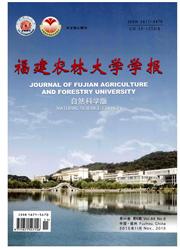

 中文摘要:
中文摘要:
应用典型样方调查法,对福建省南平市福建农林大学西芹教学林场的近60年生的老龄杉木人工林群落和30年生的杉木人工林群落的植物区系进行全面调查,并运用物种多样性测度方法进行计算分析.结果表明:各物种多样性指标基本呈现出老龄林群落高于30年生林群落的趋势,说明老龄林群落具有较为丰富的物种和复杂的垂直层次结构;老龄林群落的各物种多样性指标表现为灌木层〉藤本层〉乔木层〉草本层的格局,而30年生林群落则表现为灌木层〉草本层〉藤本层〉乔木层的格局;2个群落的各多样性指标基本呈现出随高度的增高而减小的趋势;2个群落的物种多样性特征在水平空间分布上均存在较大的差异,这可能与群落内具有较高的环境异质性有关.
 英文摘要:
英文摘要:
The plants in the old-growth Chinese fir plantation community and 30-year-old Chinese fir plantation community, which lie in Xiqin Teaching Forest Farm of Fujian Agriculture and Forestry University, were investigated completely with the method of typical plots model, and were calculated and analyzed with the measure methods of species diversity. The results showed that old- growth community had higher species diversity indexes than 30-year-old community. So old-growth community had richer species and more complicated vertical layer structure than 30-year-old community. The order of old-growth community's diversity indexes was as follows: shrub layer 〉 liana layer 〉 tree layer 〉 herb layer, but 30-year-old community's diversity indexes order was shrub layer 〉 herb layer 〉 liana layer 〉 tree layer. The diversity indexes of these two communities generally decrease with the elevation increase. There were many differences in the horizontal spatial distribution of the diversity indexes, which was possibly caused by great environmental difference.
 同期刊论文项目
同期刊论文项目
 同项目期刊论文
同项目期刊论文
 期刊信息
期刊信息
